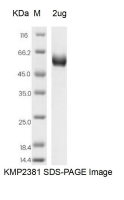Mouse CD357 Protein, Fc Tag, His Tag
-
产品编号
KMP2381
-
别名
肿瘤坏死因子受体超家族成员 18, Tumor necrosis factor receptor superfamily member 18, CD357
-
规格
- 50ug
- 100ug
- 200ug
| Alias | 肿瘤坏死因子受体超家族成员 18, Tumor necrosis factor receptor superfamily member 18, CD357 |
| Catalog Number | KMP2381 |
| Product Description | The Mouse CD357 Protein(KMP2381) is produced in HEK293 Cells and the target gene encoding Ser22-His153 is expressed with a Fc, 6His tag at the C-terminus. |
| Molecular Name | CD357 |
| Species | Mouse |
| Host | HEK293 Cells |
| Size | 50ug, 100ug, 200ug |
| Purity | >90% as determined by SDS-PAGE |
| Purification | Affinity purification |
| Endotoxin | <1.0 EU/ug determined by the LAL method |
| Formulation | PBS, pH7.4 |
| Background | Tumor necrosis factor receptor superfamily member 18(Gitr) contains 3 TNFR-Cys repeats and it have four isforms.IsformA、isformB and isformC is single-pass type I membrane protein and isformD is a secreted protein. The protein is the receptor for TNFSF18.It seems to be involved in interactions between activated T-lymphocytes and endothelial cells and in the regulation of T-cell receptor-mediated cell death. It mediated NF-kappa-B activation via the TRAF2/NIK pathway.It binds to TRAF1, TRAF2, and TRAF3, but not TRAF5 and TRAF6 and binds through its C-terminus to SIVA1/SIVA.It preferentially expressed in activated T lymphocytes and up-regulated in peripherical mononuclear cells after antigen stimulation/lymphocyte activation. |
| SDS-PAGE |  |
| Predicted Molecular Weight | 15.2 kDa |
| Storage Condition | Aliquot and store at -20℃ to -80℃. Avoid repeated freezing and thawing cycles. |
| Shipping Condition | In general, the proteins are provided as lyophilized powder which are shipped at ambient temperature. They are shipped out in dry ice if supplied in liquid form. |
| Uniprot ID | O35714 |
| Function | Receptor for TNFSF18. Seems to be involved in interactions between activated T-lymphocytes and endothelial cells and in the regulation of T-cell receptor-mediated cell death. Mediated NF-kappa-B activation via the TRAF2/NIK pathway (By similarity). |





 0
0
